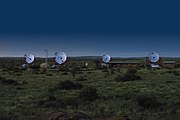High Energy Stereoscopic System: Difference between revisions
No edit summary |
|||
| Line 50: | Line 50: | ||
== External links == |
== External links == |
||
{{commons category|HESS}} |
{{commons category|HESS}} |
||
* [http://www.edupdf.org/4292/h-e-s-s-high-energy-stereoscopic-system/ High Energy Stereoscopic System - The New Window on the High-Energy Universe] Windhoek/Goellschau, Namibia |
|||
* [http://www.mpi-hd.mpg.de/hfm/HESS/HESS.html High Energy Stereoscopic System Project (H.E.S.S.)] on the internet |
* [http://www.mpi-hd.mpg.de/hfm/HESS/HESS.html High Energy Stereoscopic System Project (H.E.S.S.)] on the internet |
||
* [http://www.nature.com/cgi-taf/DynaPage.taf?file=/nature/journal/v432/n7013/abs/nature02960_fs.html ''Nature'': High energy particle acceleration in the shell of a supernova remnant] |
* [http://www.nature.com/cgi-taf/DynaPage.taf?file=/nature/journal/v432/n7013/abs/nature02960_fs.html ''Nature'': High energy particle acceleration in the shell of a supernova remnant] |
||
Revision as of 08:44, 6 February 2014
| File:HESS II gamma ray experiment official logo.jpg Logo of the H.E.S.S. experiment | |
| Alternative names | H.E.S.S. |
|---|---|
| Location(s) | Khomas Region, Namibia |
| Coordinates | 23°16.28′S 16°30′E / 23.27133°S 16.500°E |
| Organization | H.E.S.S. Collaboration |
| Altitude | 1,800 m (5,900 ft) |
| Telescope style | observatory telescope |
| Collecting area | H.E.S.S. I: 108 m2 H.E.S.S. II: 614 m2 |
| Focal length | H.E.S.S. I: f/0.8 (15 m) H.E.S.S. II: 36 m |
| Website | http://www.mpi-hd.mpg.de/hfm/HESS/ |
| | |
High Energy Stereoscopic System (H.E.S.S.) is a system of Imaging Atmospheric Cherenkov Telescopes (IACT) for the investigation of cosmic gamma rays in the energy range of 30 GeV to 100 TeV. The acronym was chosen in honour of Victor Hess, who was the first to observe cosmic rays.
The name also emphasizes two main features of the installation, namely the simultaneous observation of air showers with several telescopes, under different viewing angles, and the combination of telescopes to a large system to increase the effective detection area for gamma rays. H.E.S.S. permits the exploration of gamma-ray sources with intensities at a level of a few thousandth parts of the flux of the Crab Nebula.
H.E.S.S. has five telescopes, four with a mirror just under 12m in diameter, arranged 120m apart from each other in a square, and one larger telescope with a 28m mirror, constructed in the centre of the array. This current system, called H.E.S.S. II, saw its first light at 0:43 a.m. on 26 July 2012.[1]
As with other gamma-ray telescopes, H.E.S.S. observes high energy processes in the universe. Gamma-ray producing sources include supernova remnants, active galactic nucleii and pulsar wind nebulae. It also actively tests unproven theories in physics such as looking for the predicted gamma-ray annihilation signal from WIMP dark matter particles and testing lorentz invariance predictions of loop quantum gravity.
H.E.S.S. is located on the Cranz family farm, Göllschau, in Namibia, near the Gamsberg, an area well known for its excellent optical quality. The first of the four telescopes of Phase I of the H.E.S.S. project went into operation in Summer 2002; all four were operational in December 2003.
In 2004 H.E.S.S. was the first IACT experiment to spatially resolve a source of cosmic gamma rays.
In 2005, it was announced that H.E.S.S. had detected eight new high-energy gamma ray sources, doubling the known number of such sources. As of 2014, more than 90 TeV gamma-ray sources were discovered by H.E.S.S. [2]
-
The five-telescope H.E.S.S. array
-
A 1/30 scale model of a HESS telescope on display in the Science Museum, London.
-
Four telescopes in operation at night
References
- ^ "Largest ever Cherenkov telescope sees first light". Retrieved 27 July -07-27.
{{cite web}}: Check date values in:|accessdate=(help) - ^ "TeVCat online catalog for TeV Astronomy". Retrieved 04 Feb 2014.
{{cite web}}: Check date values in:|accessdate=(help)
External links
- High Energy Stereoscopic System - The New Window on the High-Energy Universe Windhoek/Goellschau, Namibia
- High Energy Stereoscopic System Project (H.E.S.S.) on the internet
- Nature: High energy particle acceleration in the shell of a supernova remnant
- Science: A new population of very high energy gamma-ray sources in the Milky Way
- New Scientist: Number of very high-energy gamma ray sources doubles
- Aspera European network portal




